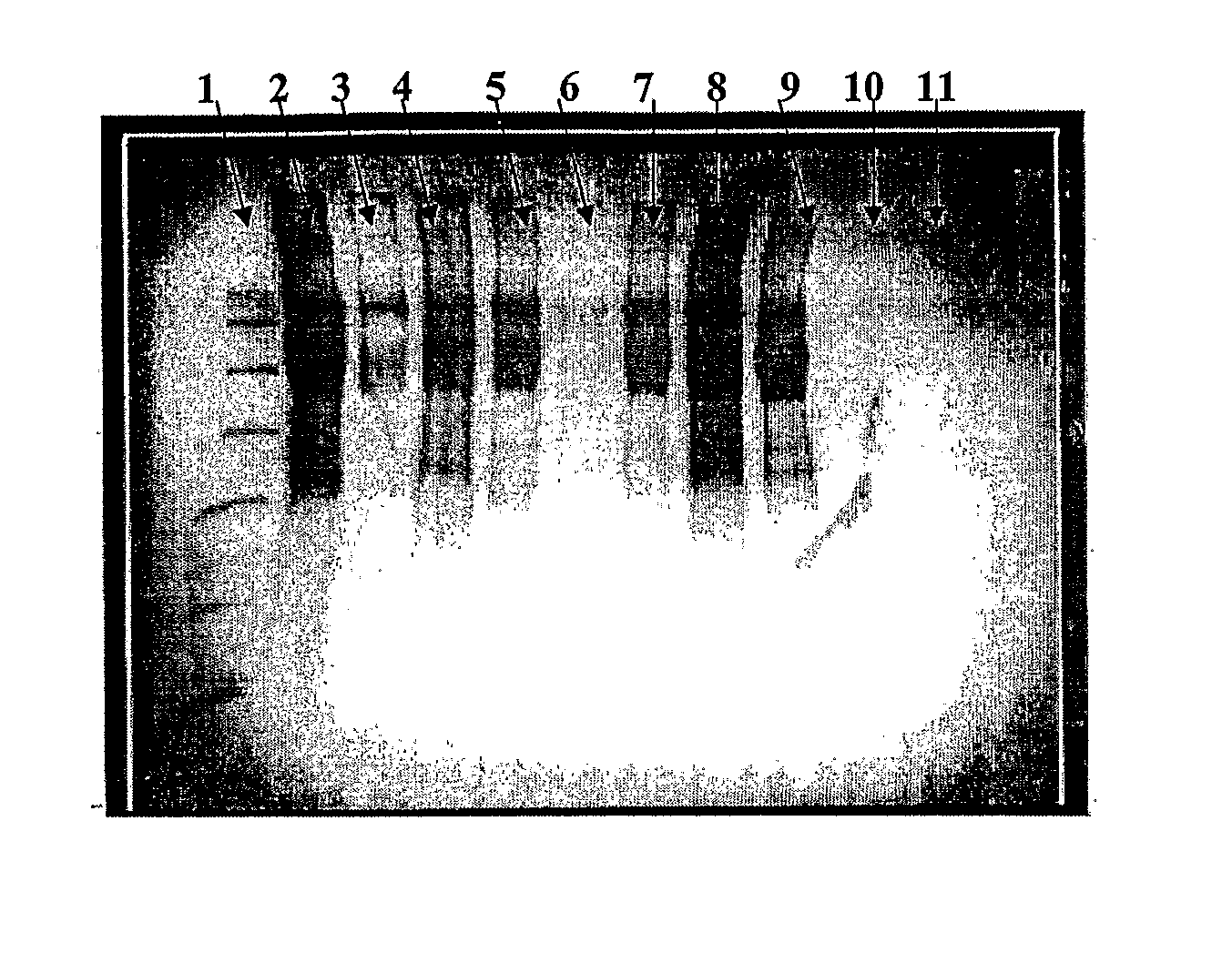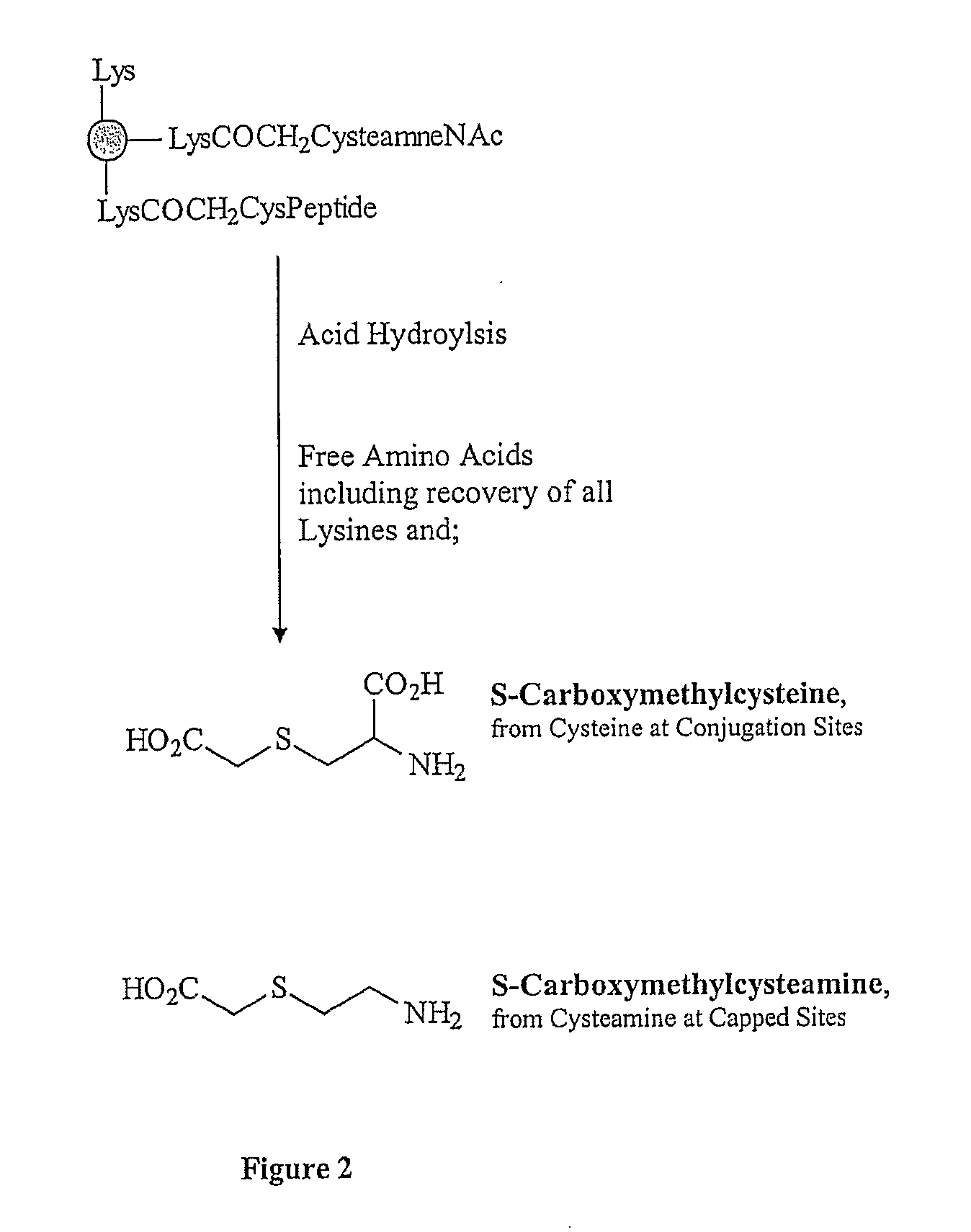Immunogenic peptide carrier conjugates and methods of producing same
a technology of conjugates and immunoglobulins, which is applied in the field of immunoglobulin carrier conjugates and methods of producing same, can solve the problems of adversely affecting the function or stability of conjugates, not always ensuring complete protective immunity against intact antigens, and potential risk of adverse events in persons or animals immunized with the preparations
- Summary
- Abstract
- Description
- Claims
- Application Information
AI Technical Summary
Benefits of technology
Problems solved by technology
Method used
Image
Examples
example 1
Conjugation of CRM197 To Aβ Peptide
[0164] Conjugation of haptens / antigenic peptides was carried out by reacting activated carrier CRM97, which has thirty-nine lysine residues, to a hapten / antigenic peptide having a pendant thiol-group using the method described below (FIG. 1). All the Aβ peptides contained a cysteine residue at the carboxy terminus to facilitate the conjugation of these peptides through the cysteinyl sulfhydryl group to the carrier protein. These peptides were produced by solid phase synthesis.
I. Activation
[0165] Free amino groups of CRM197 were bromoacteylated by reaction with an excess of bromoacetic acid N-hydroxysuccinimide ester (Sigma Chemical Co., St. Louis, Mo.) (Bernatowicz and Matsueda, 1986). To an ice-cold solution of CRM197 (˜15 mg), 10% (v / v) 1.0 M NaHCO3 (pH 8.4) was added. Bromoacetic acid N-hydroxysuccinimide ester, equal in weight to that of CRM197 used, was dissolved in 200 μL dimethylformamide (DMF), added slowly to the CRM197, and gently mix...
example 2
Preparation of Aβ Peptide-CRM197 Conjugate and Purification by Ultrafiltration Bromoacetylation of CRM197
[0167] CRM197 (100 mg) in 0.01 M sodium phosphate buffer, 0.9% NaCl, pH 7.0, was reacted with bromoacetic acid N-hydroxysucinimide ester (dissolved to 20 mg / mL in DMSO) at a 1:1 weight ratio under an argon atmosphere. The reaction was titrated as needed to maintain the pH at 7.0. The mixture was stirred in dark for 1.5 hours at room temperature. The reaction mixture was 1.2 μm filtered into the retentate reservoir of a UF / DF system (Millipore Labscale TFF, Billerica, Mass.). Purification was done using a 10K or 30K UF membrane by diafiltration (30-fold) against 0.01 M sodium phosphate buffer / 0.9% NaCl, pH 7.0. The bromoacetylated CRM197 was filtered by passing through a 0.2 μm filter. The degree of bromoacetylation was determined by reacting the activated CRM197 with cysteine, followed by amino acid analysis and quantitation of the resulting carboxymethylcysteine (CMC).
Conjuga...
example 3
Conversion by Capping of the Unreacted Bromoacetyl Groups to Aminoacetyl Groups
[0170] Bromoacetylated CRM197 (50 mg), prepared as described above in Example 2, was transferred to a reaction vessel. To the stirred solution, maintained at 2-8° C., was added 1M sodium carbonate / bicarbonate. Titration was performed to achieve a target pH of 9.0, under argon atmosphere. Separately, 50 mg of Aβ peptide was weighed out and dissolved in WFI to 20 mg / mL. To this solution was added 1 M sodium carbonate / bicarbonate until pH 9.0 was attained. The peptide solution was added to the bromoacetylated CRM197 solution, and the mixture was stirred at 2-8° C. for 14-18 hours. The remaining bromoacetyl groups were capped using 8% ammonium bicarbonate solution for 4 hours at 2-8° C.
[0171] The reaction mixture was 1.2 μm filtered into the retentate reservoir of a UF / DF system (Millipore XL), and the conjugate was purified at room temperature by 30-fold diafiltration on a 10K or 30K MWCO membrane by diafi...
PUM
| Property | Measurement | Unit |
|---|---|---|
| Immunogenicity | aaaaa | aaaaa |
Abstract
Description
Claims
Application Information
 Login to View More
Login to View More - R&D
- Intellectual Property
- Life Sciences
- Materials
- Tech Scout
- Unparalleled Data Quality
- Higher Quality Content
- 60% Fewer Hallucinations
Browse by: Latest US Patents, China's latest patents, Technical Efficacy Thesaurus, Application Domain, Technology Topic, Popular Technical Reports.
© 2025 PatSnap. All rights reserved.Legal|Privacy policy|Modern Slavery Act Transparency Statement|Sitemap|About US| Contact US: help@patsnap.com



